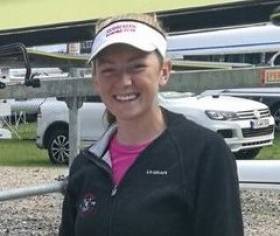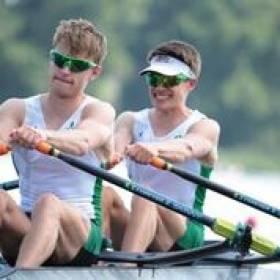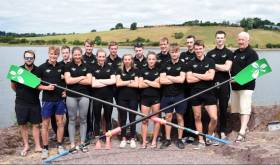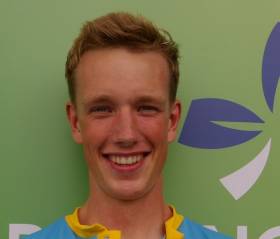Displaying items by tag: World Under23
#Rowing: The lightweight double of Aoife Casey and Cliodhna Nolan became the third Ireland boat to qualify for an A Final at the World Under-23 Championships today.
They won their repechage. Two boats would go to the A Final, and Ireland took over the lead after 1,000 metres and refused to yield despite strong charges by Britain and the Netherlands. The Dutch landed the valuable second spot.
World Rowing Under-23 Championships (Irish interest)
Women
Lightweight Double Sculls – Repechage (First Two to A Final; rest to B Final): 1 Ireland (A Casey, C Nolan) 6:54.54, 2 Netherlands 6:54.76; 3 Britain (1 F Chestnutt) 6:55.86.
#Rowing: Ireland’s lightweight double scull of Aoife Casey and Cliodhna Nolan finished fourth in their heat at the World Under-23 Championships in Florida today and must negotiate a repechage as they target a place in the A Final.
The top two in this heat qualified for the final. Switzerland took first and Germany won a battle with the Netherlands to take second. Casey and Nolan came in ahead of Fiona Chestnutt and Chloe Knight, representing Britain.
The programme was suspended because of thunderstorms. The revised schedule, if it goes ahead, has placed the remaining races for Ireland crews in late afternoon, local time. Florida is five hours ahead of Ireland.
World Rowing Under-23 Championships, Sarasota Bradenton, United States (Irish interest)
Women
Lightweight Double Sculls – Heat One (First two to A Final; rest to Repechage) 1 Switzerland 6:59.78, 2 Germany 7:02.65; 4 Ireland (A Casey, C Nolan) 7:07.28, 5 Britain (1 F Chestnutt) 7:13.48.
Third Spot in Fast Heat for Ireland Four in Florida
#Rowing: Ireland took third place in a fast heat of the women’s four at the World Rowing Under-23 Championships in Sarasota-Bradenton in Florida.
The winner alone went directly through to the A Final. The United States claimed this spot, with Britain and Ireland closing fast coming to the line. This was much the faster of the two heats.
The Ireland crew of Claire Feerick, Emily Hegarty, Tara Hanlon and Eimear Lambe would hope to qualify through their repechage on Thursday.
World Rowing Under-23 Championships, Sarasota-Bradenton, United States (Irish interest)
Men
Four, coxed – Heat Two (Winner to A Final; rest to Repechages): 1 Australia 6:11.99; 4 Ireland (B O’Rourke, R Corrigan, D Lynch, J Quinlan; cox: E Finnegan) 6:18.79.
Women
Four – Heat One (Winner to A Final; rest to Repechages): 1 United States 6:32.15; 2 Britain 6:32.96, 3 Ireland (C Feerick, E Hegarty, T Hanlon, E Lambe) 6:33.10.
#Canoeing: Noel Hendrick put in a solid performance in the men’s K1 semi-final at the canoe slalom World Under-23 Championships in Krakow, Poland, this morning. He had no touches, but his time of 91.46 seconds left him outside the top 10 who went through to the final. He finished 22nd.
Eoin Teague was off the pace in his run and was then thrown completely out of the reckoning at the finish when he misjudged gate 20 and was given a 50-second penalty.
Canoe Slalom World Under-23 Championships, Krakow (Irish interest)
K1 Semi-Final: 22 N Hendrick 91.46 seconds; 36 E Teague 144.24
#Canoeing: Liam Jegou eased into the final of the men’s C1 at the canoe slalom World Championships this morning. The Ireland paddler delivered a fault-free semi-final in 93.79 seconds to place fourth of the 10 finalists.
Canoe Slalom Under-23 World Championships, Krakow (Irish interest)
Men, C1 Semi-Final: 4 L Jegou 93.79
Fifth for McCarthy Brothers at World Under-23 Rowing
#Rowing: Ireland’s Fintan and Jake McCarthy finished fifth in their A Final of the lightweight double sculls at the World Under-23 Championships in Poznan, Poland, today. Spain took over from Germany to lead in the middle stages of the race and they saw off an Italian challenge late in the race. Italy slotted into second, and a race developed between Germany, Chile and Ireland for the bronze medal. Ireland could not crack it, and Germany took third, with Chile fourth.
World Under-23 Championships, Poznan, Poland (Irish interest):
Men
Lightweight Double Sculls – A Final: 1 Spain 6:16.29, 2 Italy 6:16.66, 3 Germany 6:17.87; 5 Ireland (F McCarthy, J McCarthy) 6:20.42.
#Rowing: The McCarthy twins, Jake and Fintan, gave Ireland its fourth A Finalist at the World Under-23 Rowing Championships in Poland today. They finished second in the semi-final of the lightweight double sculls. This was a close race: Spain led early on and eventually won from fast-finishing Ireland, who had won a battle with New Zealand, who took the third qualifying spot, and Portugal, who took fourth.
The early stages looked very promising for the women’s lightweight double of Lydia Heaphy and Margaret Cremen in their semi-final. They led to 700 metres, but then Greece and, with a more consistent challenge, Italy, moved ahead. The early part of the third quarter saw the Ireland crew fight a battle with Australia. The Australians moved into a clear third and from there Ireland slipped back. They finished fifth, behind the Netherlands, who took fourth.
World Under-23 Rowing Championships, Day Four, Poznan, Poland
Men
Lightweight Double Sculls – Semi-Finals (First Three to A Final; rest to B Final) 1 Spain 6:41.66, 2 Ireland (F McCarthy, J McCarthy) 6:42.45, 3 New Zealand 6:44.17.
Single Sculls – Semi-Final (First Three to A Final; rest to B Final): 1 United States (B Davison) 7: 14.65, 2 Ireland (R Byrne) 7:17.88, 3 Germany (M Weber) 7:24.24.
Lightweight Single Sculls – D Final (Places 19 to 24): 2 Ireland (H Sutton) 7:21.95.
Women
Lightweight Double Sculls – Semi-Finals (First Three to A Final; rest to B Final): 1 Italy 7:24.69, 2 Australia 7:30.08, 3 Greece 7:31.23; 5 Ireland (L Heaphy, M Cremen) 7:47.66.
#Rowing: Ireland’s Ronan Byrne won his quarter final of the men’s single sculls at the World Under-23 Rowing Championships in Poznan, Poland, taking a place in the A/B Semi-Finals. The UCC man was the clear leader right through, with Russia and Brazil slotting into the other qualification places for the last 12.
Hugh Sutton finished fifth in his quarter-final of the lightweight single sculls. The top three – Austria, South Africa and Germany – were established early, and Sutton held fifth through the race.
World Under-23 Rowing Championships, Poznan, Poland
Men
Single Sculls – Quarter-Final (First Three to A/B Semi-Finals; rest to C/D Semi-Finals): 1 Ireland (R Byrne) 7:20.26.
Lightweight Single Sculls – Quarter-Final (First Three to A/B Semi-Finals; rest to C/D Semi-Finals): 5 Ireland (H Sutton) 7:55.8.
#Rowing: Jake and Fintan McCarthy raced brilliantly to win their heat and qualify directly for the A/B Semi-Finals at the World Under-23 Rowing Championships in Poland this morning. There was just one direct qualification place on offer in this heat of the lightweight double sculls and Italy gave Ireland quite a race. The two crews were locked together as they approached the 1500-metre mark – but then the McCarthy twins went. They led by .18 of a second at 1500 metres and sprinted away from their rivals to win well.
Lydia Heaphy and Margaret Cremen made a solid start to their campaign in the women’s lightweight double by taking the second and final qualification spot in their heat. They were fastest to the 500 metre mark, but Britain’s Susannah Duncan and Danielle Semple took over from there. They would build their lead to win by almost eight seconds. Cremen and Heaphy secured their spot, staying well clear of third-placed Poland.
World Under-23 Championships, Poznan, Poland (Irish interest; selected results)
Men
Lightweight Double Sculls – Heat Three (First to A/B Semi-Finals; rest to Repechage): 1 Ireland (F McCarthy, J McCarthy) 6:35.94.
Women
Lightweight Double Sculls – Heat Four (First Two to A/B Semi-Finals; rest to Repechage): 2 Ireland (L Heaphy, M Cremen) 7:37.99.
#Rowing: David O’Malley and Shane Mulvaney won their repechage at the World Under-23 Championships in Plovdiv in Bulgaria today and qualified for the A Final of the lightweight pair. The UCD men led the field through the race, with only France staying close. The two finished in that order, and both qualified for Saturday’s decider.
World Under-23 Day Championships, Plovdiv, Bulgaria, Day Two (Irish interest)
Men
Lightweight Pair – Repechage (First Two to A Final; rest to B Final): 1 Ireland (S Mulvaney, D O’Malley) 6:37.47, 2 France 6:40.28.
Lightweight Double Sculls – Heat Four (First to A/B Semi-Final; rest to Repechage): 1 Ireland (F McCarthy, J McCarthy) 6:22.85; 2 Poland 6:27.26.





































































